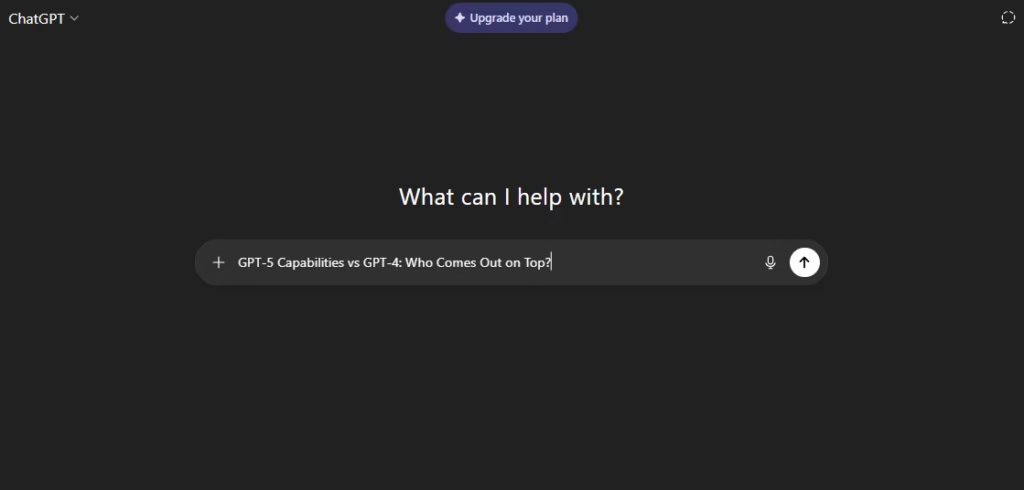GPT-5 Capabilities vs GPT-4: Who Comes Out on Top?

With GPT-5 now available, the AI world faces the same big question: Should you stick with GPT-4 or upgrade? While both models are powerful, GPT-5 capabilities go far beyond incremental improvements. This guide breaks down their strengths, weaknesses, and ideal use cases so you can decide which one works best for you.
GPT-5 vs GPT-4 – At a Glance
| Capability | GPT-4 (2023) | GPT-5 (2025) |
|---|---|---|
| Reasoning Ability | High | Advanced multi-step reasoning |
| Context Window | 128K tokens | 256K tokens |
| Multimodal Inputs | Text + Image | Text, Image, Audio, Video |
| Specialization | General-purpose AI | Industry-tuned modes & APIs |
| Hallucination Rate | ~8–10% | ~3–5% |
| Energy Efficiency | Standard | 20–25% more efficient |
Key Capabilities of GPT-5
1. Advanced Multi-Step Reasoning
GPT-5 handles complex problem-solving with improved logical flow, making it ideal for strategy, legal analysis, and advanced research.
2. Extended Context Processing
With 256K tokens, GPT-5 can remember and reference massive conversations, books, or large datasets without losing track.
3. True Multimodal Support
Unlike GPT-4, GPT-5 can process text, images, audio, and video simultaneously — useful for multimedia content analysis.
4. Industry-Specific Adaptations
GPT-5 offers fine-tuned modes for industries like finance, healthcare, and law, providing more accurate outputs for specialized needs.
5. Higher Reliability
Reduced hallucinations and better fact-checking integration mean safer, more trustworthy answers.
When GPT-4 Might Be Enough
GPT-4 remains a strong choice if you:
- Work mainly with short-form content
- Don’t require video/audio understanding
- Need a budget-friendly AI solution
- Run projects with low context requirements
Ideal Use Cases for GPT-5
- Business Intelligence: Analyzing annual reports in text, audio, and video formats
- Education: Converting lecture videos into structured study guides
- Legal: Summarizing complex case files
- Marketing: Turning podcasts into ad scripts
- Tech: Reviewing large-scale codebases in one session
Upgrade Decision Framework
- Step 1: List your most frequent AI tasks
- Step 2: Identify whether they require multimodal input or long context windows
- Step 3: Compare cost vs. productivity gains
- Step 4: Test both models with the same prompts for accuracy & speed
If Step 2 answers “Yes,” GPT-5 is the stronger choice.
FAQs
Q1: Is GPT-5 better than GPT-4 for general users?
For casual tasks, both work well, but GPT-5’s capabilities shine in advanced, multimodal, and long-context scenarios.
Q2: Can GPT-5 handle video input?
Yes, GPT-5 supports video analysis alongside text, image, and audio processing.
Q3: Does GPT-5 cost more than GPT-4?
Yes, but its improved efficiency and output quality can offset the cost for heavy users.
Q4: Is GPT-4 still supported?
Yes, GPT-4 remains widely available and supported for most API and ChatGPT use cases.
Q5: Which model is best for business applications?
GPT-5, due to its industry-tuned modes and improved accuracy.
Conclusion
If you rely on AI for complex, multi-format, and high-volume tasks, GPT-5’s capabilities will significantly boost your productivity and accuracy.
However, if your needs are simple and cost-sensitive, GPT-4 remains a solid option in 2025.
Pingback: Are GPT-5 Hallucinations Really Reduced Compared to GPT-4?
Pingback: What Is GPT-5? Features, Differences, and What’s New